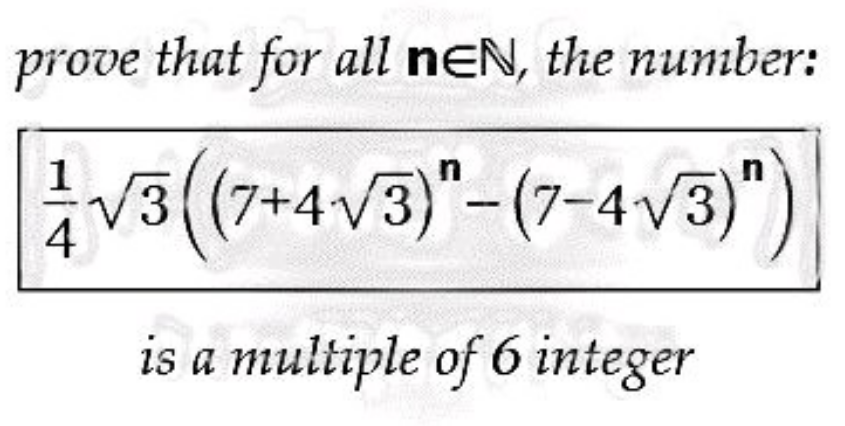
Question and Answers Forum
Question Number 185137 by emmanuelson123 last updated on 17/Jan/23

Answered by CElcedricjunior last updated on 17/Jan/23
![montrons que ∀n∈IN ((√3)/4)[(7+4(√3))^n −(7−4(√3))^n ]≡0[6] posons p(n)=((√3)/4)[(7+4(√3))^n −(7−4(√3))^n ] ∗pour n=0 on a ((√3)/4)[(7+4(√3))^0 −(7−4(√3))^0 ]=((√3)/4)(1−1)=0≡0[6] D′ou^� p(0) vrai ∗pour n≥0 supposons p(n) vraie et montrons que p(n+1) l′est aussi au rang (n+1) on a ((√3)/4)[(7+4(√3))^n −(7−4(√3))^n ]≡0[6] =>(((√3)(7+4(√( 3)))^n )/4)≡((√3)/4)(7−4(√3))^n [6] =>(7+4(√3))^n ≡(7−4(√3))^n [6] =>(7+4(√3))^(n+1) ≡(7−4(√3))^(n−1) [6] =>(7+4(√3))^(n+1) −(7−4(√3))^(n−1) ≡0[6] =>((√3)/4)[(7+4(√3))^(n+1) −(7−4(√3))^(n+1) ]≡0[6] cas (7−4(√3))^(n−1) ≤(7−4(√3))^(n+1) d′ou^� p(n+1) vraie donc ∀n∈IN ((√3)/4)[(7+4(√3))^n −(7−4(√3))^n ]≡0[6]](Q185145.png)
Commented by aba last updated on 17/Jan/23

Answered by JDamian last updated on 17/Jan/23
![S_n =(√3)[(7+4(√3))^n −(7−4(√3))^n ]= =(√3)Σ[C_(n,k) ∙(7^(n−k) ∙(4(√3))^k ] 1≤k≤n k=2p+1 S_n =Σ[C_(n,k) ∙(7^(n−k) ∙(√3)∙(4(√3))^k ] (√3)∙(4(√3))^k =(√3)∙(4(√3))^(2p+1) = =(√3)∙[(4(√3))^2 ]^p ∙4(√3)= =48^p ∙12 S_n =Σ(C_(n,k) ∙7^(n−k) ∙48^p ∙12) (48^p ∙12) mod 6 = 0 ⇒ S_n mod 6 = 0](Q185160.png)
Commented by aba last updated on 17/Jan/23

Commented by aba last updated on 17/Jan/23
![a^n −b^n =(a−b)(Σ_(k=0) ^(n−1) a^k b^(n−1−k) ) S_n =((√3)/4)[8(√3).(Σ_(k=0) ^(n−1) (7+4(√3))^k (7−4(√3))^(n−1−k) )] =6(Σ_(k=0) ^(n−1) ((√3)+2)^(2k) ((√3)−2)^(2(n−1−k)) ) ≡0mod(6)](Q185162.png)
